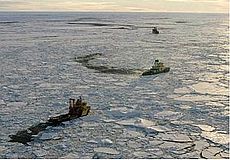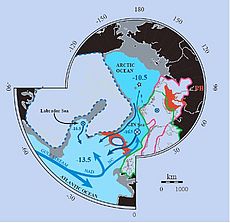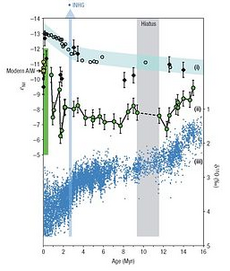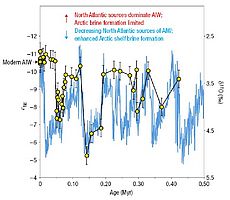Opening of the Atlantic-Arctic Gateway
One of the foci of research on these sediments was the timing of the establishment of the Fram Strait oceanic gateway between the North Atlantic and the Arctic Ocean, which had previously only been accessible through tectonic modeling. Above a 26 million year hiatus the ACEX sediments have an age of 18.2 million years and are characterized by organic-rich sediments that also prevailed prior to the hiatus and document that the deep Arctic Ocean was not well-ventilated but was rather an almost enclosed brackish basin which more resembled a large lake. At a depth of 190 m and an age of 17.3 million years there is a sharp transition from the organic rich, black sediments to organic-poor brownish sediments. This color change documents an increased supply of oxygen and thus the onset of deep ventilation. This ventilation could only be established with a Fram Strait opened to an extent that allowed large amounts of salt-rich Atlantic waters to penetrate the Arctic Ocean and supply oxygen to intermediate and deep waters (Jakobsson et al., 2007). The early opening was conformed new tectonic information as well as a model constraining the minimum width of the opening strait to allow deep convection.
Frank, M., Backman, J., Jakobsson, M., Moran, K., O’Regan, M., King, J., Haley, B.A., Kubik, P.W. and Garbe-Schönberg, D. (2008): Beryllium isotopes in central Arctic Ocean sediments over the past 12.3 million years: Stratigraphic and paleoclimatic implications.- Paleoceanography, in press.
Haley, B.A., Frank, M., Spielhagen, R.F. and Eisenhauer, A. (2008): Influence of brine formation on Arctic Ocean circulation over the past 15 million years.- Nature Geoscience 1, 68-72.
Jakobsson, M., Backman, J., Rudels, B., Nycander, J., Frank, M., Mayer, L., Jokat, W., Sangiorgi, F., O’Regan, M., Brinkhuis, H., King, J., and Moran, K. (2007): The Early Miocene onset of a ventilated circulation regime in the Arctic Ocean.- Nature 447, 986-990.
Moran, K., Backman, J., Brinkhuis, H., Clemens, S.C., Cronin, T., Dickens, G.R., Eynaud, F., Gattacceca, J., Jakobsson, M, Jordan, R.W., Kaminski, M., King, J., Koc, N., Krylov, A., Martinez, N., Matthiessen, J., McInroy, D., Moore, T.C., Onodera, J., O’Regan, A.M., Pälike, H., Rea, B., Rio, D., Sakamoto, T., Smith, D.C., Stein, R., St. John, K., Suto, I., Suzuki, N., Takahashi, K., Watanabe, M., Yamamoto, M., Farrell, J., Frank, M., Kubik, P., Jokat, W. and Kristoffersen, Y. (2006): The Cenozoic palaeoenvironment of the Arctic Ocean.- Nature 441, 601-605.






